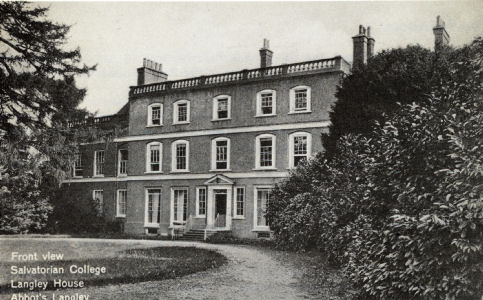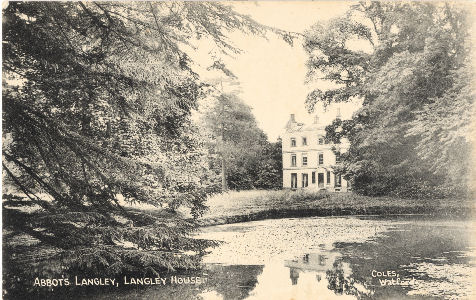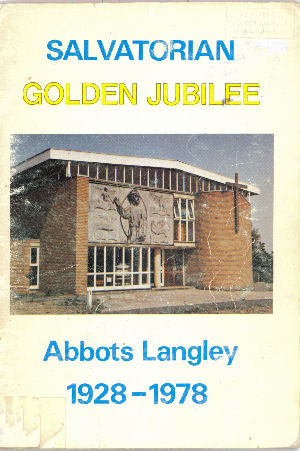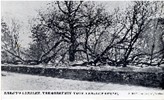|
Abbots Langley
Langley House |
|
|
|

Langley House [Salvatorian Golden
Jubilee] |
Situated across the road from the new library, Langley House is now the Breakspear Hospital. This is a private clinic run by Dr. Jean Munro and it specialises in environmental medicine and the treatment of allergies.
This large house was built, for his retirement, in the 1770's by Sir John Cope Freeman. Sir John later became County Sheriff of Hertfordshire and had previously been owner of a large slave plantation in Jamaica. In 1759 he had the road through the village diverted around a pond which stood in a field to the front of the
house. This kept the road away from the house but did little to soften the rather unpleasant, sharp bend in the road, which now runs up towards the mini-roundabout at the top end of the High Street.
The house, which was stuccoed and enlarged in 1830, has five bays and a two and a half storey structure. The owners of the house in the nineteenth century were Mrs Allen (1804-20), General Dyce (1821-28), William Bagot, and lastly, Oliver Hargreaves whose step-son Captain George Ranken had the misfortune to be the last British officer killed in the Crimean War. From 1886 until 1905, the house was home to Mr. Robert Henty, who was the brother of the author, G.A. Henty. It was then purchased by Sir Robert Molesworth Kindersley, knighted in 1917. Lord Kindersley who served as Governor of the Bank of England lived here between 1906 and 1923. In 1929 Langley House was bought by the Salvatorian Fathers of Wealdstone for their Novitiate. It also served as the Catholic church for the district and Mass was first conducted from a chapel established in the former Billiards room of the house. Prior to its conversion into a hospital in 1986, the house was internationally known as Breakspear College, a Roman Catholic Seminary.
Scott Hastie,
Abbots Langley, A Hertfordshire Villag, 1993
 |
|
Langley House
Abbots
Langley
Publisher:
Coles,
Watford
Back circa
1904
|
Pope Adrian IV
In Abbots Langley we find Popes Road, Adrian Road and Breakspear Road, reminders that a now famous cleric once lived in the area. Nicholas Breakspear was born about the beginning of the 12th century in the Parish of Abbots Langley, on the outskirts of the hamlet of Bedmond in Hertfordshire. The place of his birth, Breakspear Farm, was demolished in the early 1960's to make way for the building of modern houses.
Young Nicholas Breakspear was a growing boy at the time that the parish Church of St. Lawrence was being built. Little is known of his early childhood. His father, Robert, was a farmer and it seems that he was the first of 'the Breakspear family to live in this part of Hertfordshire. A family quarrel appears to have been the cause of Robert, his wife and son Nicholas leaving Harefield. The move to Bedmond meant a lower standard of living for the family, but Robert obtained employment at St. Alban's Abbey, five miles away and this resulted in the monk's accepting Nicholas into the Abbey School. The strict discipline there had a lasting effect on Nicholas, who hoped to become a monk and a priest.
When the time came for Nicholas to apply to enter the Monastery, the Abbot was not impressed with Nicholas's intellectual capabilities and told him to spend a few more years at his studies. So Nicholas made the long journey to Paris, begging the necessities of life as he went; he spent some years wandering around France, studying at the various centres of learning, finally joining the Canons Regular of St. Augustine in the monastery of St. Rufus, near Avignon. There he was known to be "elegant in person, pleasant in countenance, prudent in speech and of regular obedience - a most exact observer of regular discipline."
In the year 1137 Abbot William died and Nicholas was elected Abbot of the Monastery. Unfortunately, the monks found him too strict for their liking, his being a foreigner did not help matters; they appealed to the Pope requesting him to remove Nicholas from office. Pope Eugenious heard the complaints, decided in favour of Nicholas. Later trouble broke out again, so the Pope called Nicholas to Rome and consecrated him Bishop of Albano in Italy early in 1150. Shortly after this he was created a Cardinal. Albano is a diocese adjacent to the diocese of Frascati, where another Briton, Henry, Cardinal Duke of York, was subsequently bishop. Some two years later Cardinal Breakspear was sent to Norway as Papal Legate to re-organise the whole Scandinavian Hierarchy. He is still held in high esteem by those countries and much of his work has lasted to the present day.
n the autumn of 1154, Cardinal Breakspear returned to Rome, where on Saturday, December 4th, he was unanimously elected to the chair of S1. Peter. His brief reign of four years, was filled with turmoil. There were troubles in Rome, in Sicily, in Italy and in Germany. Throughout these difficulties the Pope acted with a dignity and strength which had not been seen in Rome for many years. A contemporary of his, John of Salisbury, says that "on his death Rome mourned for him and the whole Catholic world wept most bitter tears and none sorrowed so much over his death as England, who gave him birth". Pope Adrian died at Anagni on September 1 st, 1159, and the people of Rome clamoured for his body to be brought there, where it now lies among the tombs of the Popes in the crypt of S1. Peter's.






